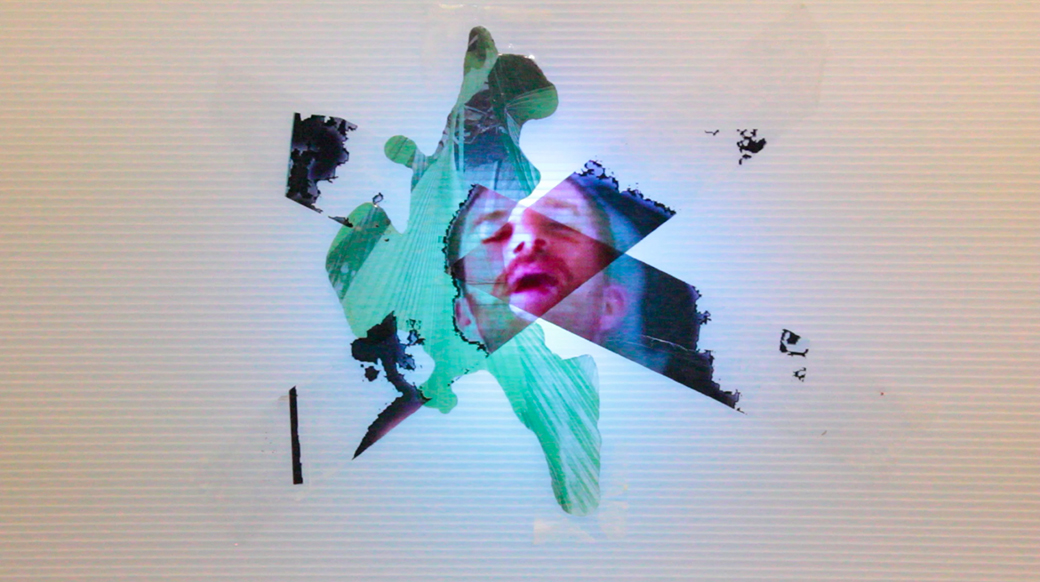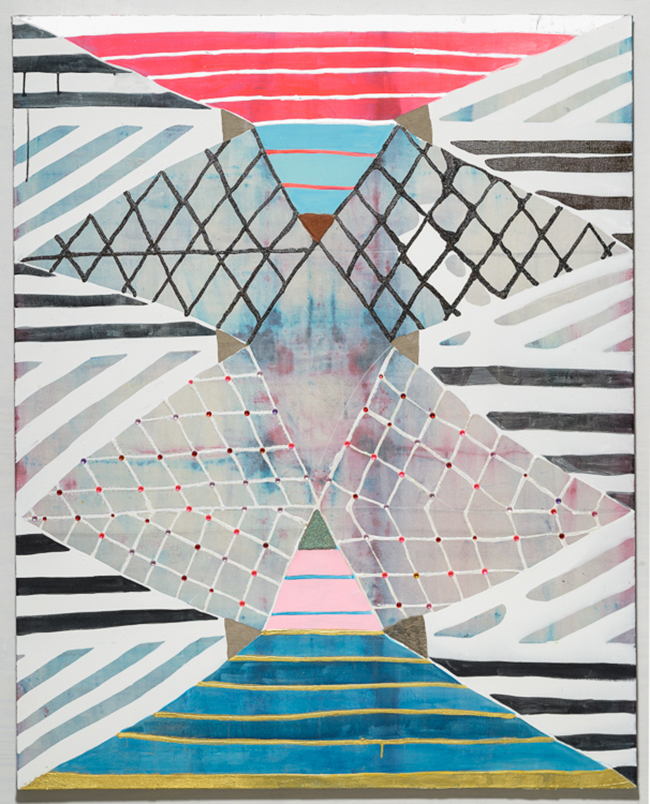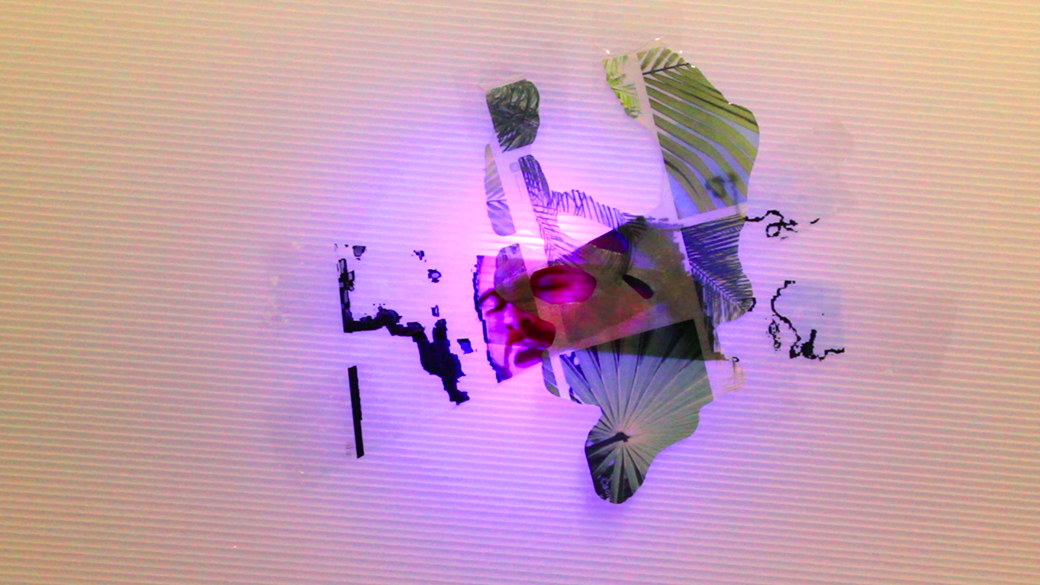
Laurel Sparks. Cauldron, 2013. Acrylic, gold pigment, glitter, cut-outs, linen collage on canvas; 60 x 48 inches. Courtesy the artist.
Those of us invested in art already understand its potential for transformation, but contemporary artists Laurel Sparks and Ivan LOZANO use the tools of magic to take this idea to a new level. By using sigils—magical symbols, or visual emblems that consolidate an idea with one’s will to launch the idea into physical existence—Sparks and LOZANO re-signify ideas of artistic intention and generate new conceptions of meaning and content in their work.
Austin Osman Spare, an artist and practitioner in Aleister Crowley’s circle in early-twentieth-century London, worked at the intersection of art and the occult. Spare updated medieval and Renaissance conceptions of the sigil from a device used to call forth angels, demons, and such otherworldly beings to its contemporary manifestation. Spare’s method involves writing down one’s intention and then—seeing language not as text but as image—reconfiguring the written marks into an abstract design that embeds the intention into a subliminal indecipherable code. Spare advised charging the sigil by meditating or masturbating to launch the intention in the cosmic fabric of the universe, thus allowing it the possibility to manifest into reality. The resulting sigil carries all the psychic and psychical energy of the original intention.

Ivan LOZANO. AFFIRMATION 7 (excerpt), 2014. Digital video loop; 5:00. Courtesy the artist.
Whereas Roland Barthes posited the photograph as “a message without a code,” the sigil is a code without a referent and definitely not a cipher, as consciously forgetting the embedded message makes its image more potent.1 Symbols operate through analogy: the color red equals “stop.” Patterns operate by abstracting an object to its essential geometry and repeating it; a feather, and not the eponymous fish skeleton, is the source of the herringbone pattern. Emblems complicate the relationship between image and referent further by serving as illustrations of ideas. For instance, the lion is a symbol of bravery and courage as well as the emblem of Belgium. The Nike swoosh is an image that has no inherent meaning, but it serves as a symbol of swiftness and, as the corporate logo, an emblem of the brand’s products and status. If the message “Buy these shoes” was embedded into the swoosh, a sigil would be created. The sigil operates more like a talisman, as its form and content are derived from a ritualistic engagement that imbues it with intention.

Laurel Sparks. Neither Neither, 2013. Acrylic, glitter, rhinestones, crushed turquoise, vortex dirt, cut-outs, linen collage on canvas; 60 x 48 inches. Courtesy the artist.
The painter Laurel Sparks and the new-media artist Ivan LOZANO look to Spare as well as to Genesis Breyer P-Orridge, the artist, musician, and cult icon who brought Spare’s ideas into the realms of contemporary art and music in the 1980s. The music P-Orridge created with the bands Throbbing Gristle and Psychic TV can be though of as auditory sigils. In collages created with interdimensional collaborator, Lady Jaye Breyer, P-Orridge cuts up and reconfigures images in the same way words are divided into individual marks and reassembled into glyphs in Spare’s original formulation. LOZANO and Sparks similarly extend their magical and artistic investigations into alternate mediums and dimensions to embed their works with messages of personal and global concern.

Ivan LOZANO. AFFIRMATION 2 (excerpt), 2014. Digital video loop; 5:00. Courtesy the artist.
Laurel Sparks uses Spare’s methods of encryption to construct elaborate algorithms and systems as the foundation of her paintings’ compositions. Treating the process of painting as a form of alchemy—the medieval precursor to chemistry that aimed to turn lead into gold—Sparks works toward moments when the precision of enacting her system’s logic meets irrationality and instability, as that logic breaks down into mystery. In fact, Sparks designs her systems to seek chaos. For example, an active word or symbol may be encoded in red lines while blue lines indicate passivity or reduction. When blue and red lines cross on the surface of the canvas, these lines may generate a purple square or triangle, a symbol of alchemical transformation. But other crossings may be more or less compatible and will instead necessitate the addition of other elements or the removal of parts of the canvas. This is but one example among many in Sparks’s process, which also encrypts various materials: preexisting symbols; patterns derived from geomancy, the I Ching, and other metaphysical divination systems; different application methods like staining, pouring, and brushing; color, line, and language. By employing a combination of precision and rupture in her process, Sparks unsettles the fixity of the painted image. The results are paintings that vibrate with energy, intensified by Sparks’s use of materials like powdered crystals, dust from Sedona vortexes, glitter, beads, and bells. While the original message is inscrutable to both Sparks and the viewer, it hides out in the open within a webbed network of correspondences.
Ivan LOZANO explores the materiality of digital technology and the medium-specificity of the Internet. Over the course of his artistic career, he has used the Internet as a divination tool and also as a means of channeling and communing with artists, filmmakers, and porn stars who have died from AIDS, in his search for intergenerational queer elders. Since the Internet and all digital technology operate through a set of codes, LOZANO piggybacks his intentions on these codes, as readymade sigils. As he explained in an interview,
While the sigil was originally a glyph deployed to call forth an entity to assist with a specific task, a computer file is a set of instructions in a language––a glyph––fed to a computer––an entity––to perform that task. For example, a file called flower.jpg is not an image of a flower but a set of instructions that are performed by a processor and experienced by us as a picture of a flower. Each of my videos, gifs, and photographs is always a performance of code by a machine.2

Ivan LOZANO. AFFIRMATION 6 (excerpt), 2014. Digital video loop; 5:00. Courtesy the artist.
LOZANO exploited technology’s functionality in Narcissus Rising, his project for the online magazine Pastelegram. He created hypersigils, or sigils that unfold over time and space, by embedding excerpts from a self-help audio book, Disarming the Narcissist, into a series of online videos he calls Affirmations. Highlighting the narcissistic tendencies of online affinity groups, these videos aim to subliminally deprogram the viewer through her meditative witnessing of the hypersigil.
After more than a half century of deconstructionist writing toward revealing the codes that underpin our lives, LOZANO and Sparks are rebuilding codes on a personal scale. Their reinvestment in belief as a tool and the power of magic is not based in wishful thinking but rather in a rigorous application of will and discipline that reconceptualizes artistic practice as ritual.
1. Roland Barthes, “The Photographic Message,” Image–Music–Text; translated by Stephen Heath (New York: Hill and Wang, 1978).
2. From the author’s g-chat conversation with LOZANO in November 2014.



